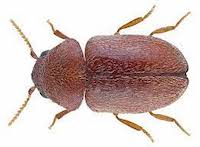WHAT DO CIGARETTE BEETLES LOOK LIKE

Adult cigarette beetles, Lasioderma serricorne (Coleoptera: Anobiidae), are quite small, measuring about 1/8 of an inch and are reddish brown. They have a rounded, oval shape and the head is often concealed by a plate covering the first region of the thorax, called the prothorax, when the beetle is viewed from above. The wings are covered with fine hairs. When disturbed, they often pull in their legs, tuck their head, and lay motionless. They prefer to reside in dark or dimly lit cracks, nooks, and crevices but become active and fly readily in bright, open areas probably in an attempt to find refuge. They are most active at dusk and will continue activity through the night. Adults do not feed but will drink liquids.
Cigarette beetles look almost identical to drugstore beetles but can be distinguished by two easily identifiable characters: the antennae of the cigarette beetle are serrated (like a series of teeth on a saw). It gets its species name, “serricorne,” from this feature. Serricorne is latin for “serrated antennae.” Alternately, the antennae of the drugstore beetle ends in a 3-segmented club, with the last 3 segments larger and almost swollen like. The other difference is that drugstore beetle elytra (hard wing coverings that make up the beetle’s “shell”) have rows of pits giving them a striated (lined) appearance while those of the cigarette beetle are smooth with fine hairs.
Cigarette beetles look almost identical to drugstore beetles but can be distinguished by two easily identifiable characters: the antennae of the cigarette beetle are serrated (like a series of teeth on a saw). It gets its species name, “serricorne,” from this feature. Serricorne is latin for “serrated antennae.” Alternately, the antennae of the drugstore beetle ends in a 3-segmented club, with the last 3 segments larger and almost swollen like. The other difference is that drugstore beetle elytra (hard wing coverings that make up the beetle’s “shell”) have rows of pits giving them a striated (lined) appearance while those of the cigarette beetle are smooth with fine hairs.